One of the cutest rarities ever - Montezuma Quail. It lives in Mexico and extreme southwestern United States. They are extremely secretive, don't stray very far from their home fields, and hide very well in the grass. We saw a small covey of them during a birding trip to Southern Arizona - but only after several days of trying with a very experienced guide.
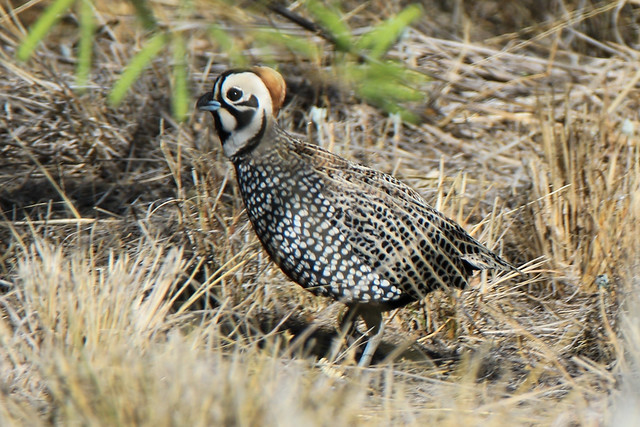
A bird of altogether opposite climates and preferences, the Northern Hawk Owl lives mainly in Canada, although a few individuals might come down to northern United States in the winter. It is uncommon and solitary, but (unlike most owls) it is active during the day. This might be the only Northern Hawk Owl I'll ever see - we stumbled upon it by luck near Duluth, MN. (Although it's been reported in the general area previously, just not where we saw it.)
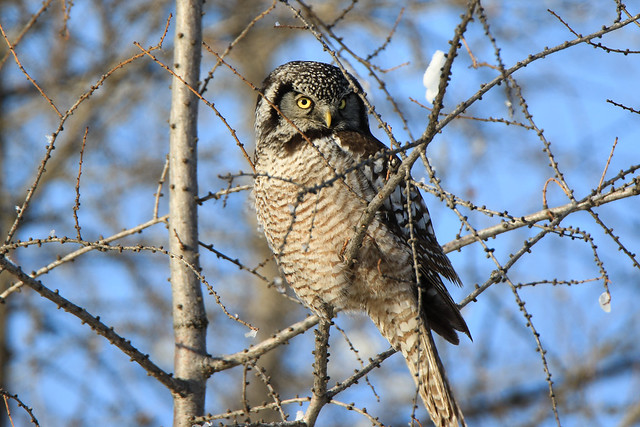
This is a pair of Gyrfalcons, the biggest falcons in the world. They are rare, and live in remote, scarcely populated northern territories around the globe. About the only reliable place to see them in the world is a stop along the Denali National Park bus route in Alaska, where this pair had a nest for a long time. Even then, it took me two bus trips to finally catch them. (There are other Gyrfalcon nests along the bus route, but much farther away and less reliable.)
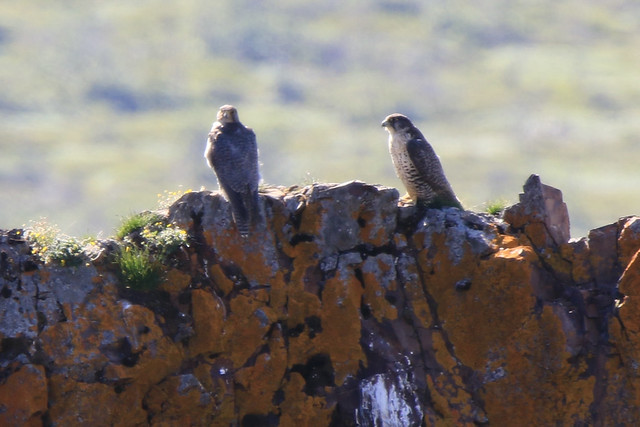
Ferruginous Hawk is uncommon in the American West, where it soars above the plains and hunts for rabbits, snakes, squirrels, and other rodents. It is the largest of our soaring hawks, but not often seen. I've tried several known nesting locations without any luck, but finally saw a few of them in flight while driving on Rt 20 in eastern Oregon. (And no, I didn't take this picture while driving - I did get out of the car to take it.)
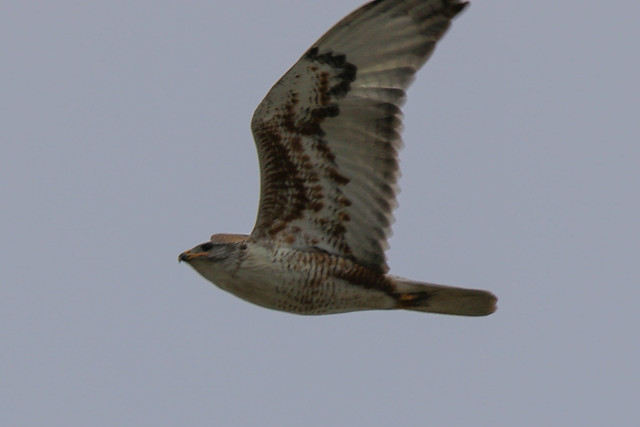
Tufted Ducks are common in Europe, and are uncommon but regular vagrants to the United States in the winter. Every winter, there is a report of a few of them around NYC area. I've been chasing these reports for several years, with no luck. Finally two years ago, after several tries, I was able to find this female on a lake in Point Pleasant NJ.

When it rains, it pours - soon afterwards, chasing another report, we also found this male Tufted Duck in Sandy Hook, NJ. (Can you see why they call it "Tufted"?)
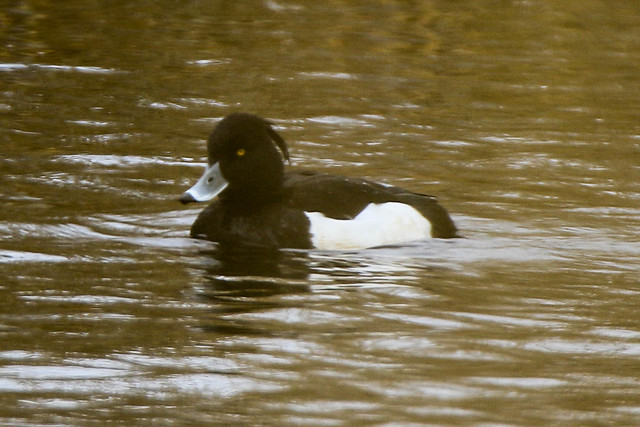
I had to go to Minnesota for this one. North Minnesota. In February. This is a Purple Finch, a native version of the introduced and more common House Finch. Purple Finches do come down to the NYC area occasionally - there were a few of them in Central Park last winter, but never when I was there. Minnesota in the winter was the first time I had a chance to see one.
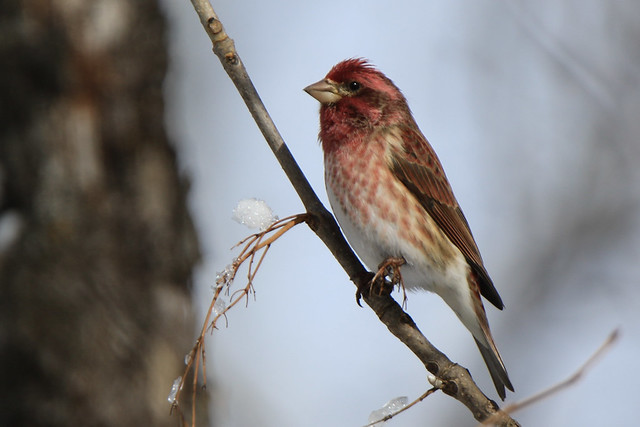
One of the many birds that I had to chase and chase again is an endangered Roseate Tern. There are actually two of them in this picture, the ones in the center (the one in the foreground is an adult, and the one right behind it is a juvenile). They look a lot like the Common Terns that they like to share a nesting colony with, and picking out one of them among the hundreds of Commons can be maddening. I saw these two Roseate Terns one late August in Cape Cod, finding them by sheer luck in a large flock of roosting Commons. (Notice how the juvenile is banded - you can see a metal ring around its leg.)
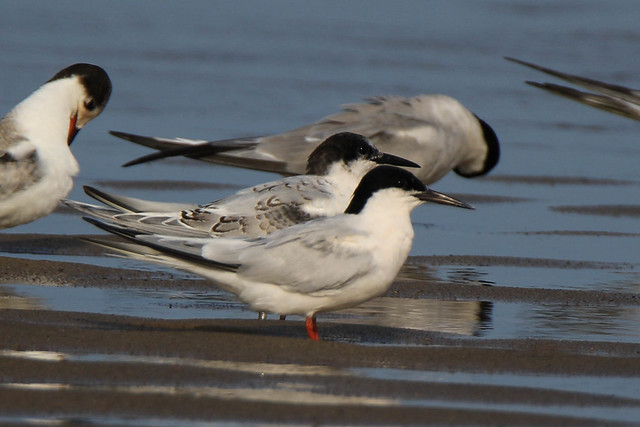
Long time ago, Florida was full of Smooth-Billed Ani's. Now, they are a big rarity there. We chased multiple reports and locations, finally finding this one after sunset in a Plantation, FL golf course. (There is also a Groove-Billed Ani, a bit less rare, and more reliable to be found in southern Texas.)
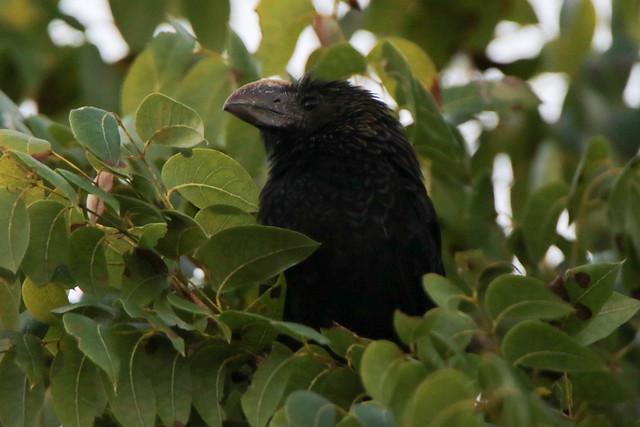
This is an uncommon and range-limited LeConte's Thrasher, found in the deserts of southwestern US and Mexico. There is really only one reliable spot for it in the US, a desert spot near Phoenix, AZ (marked on birding maps literally as "LeConte's Thrasher Stakeout Place"). The best time to find them is November, when they sing to stake out territories and attract mates. This is where we saw this one.
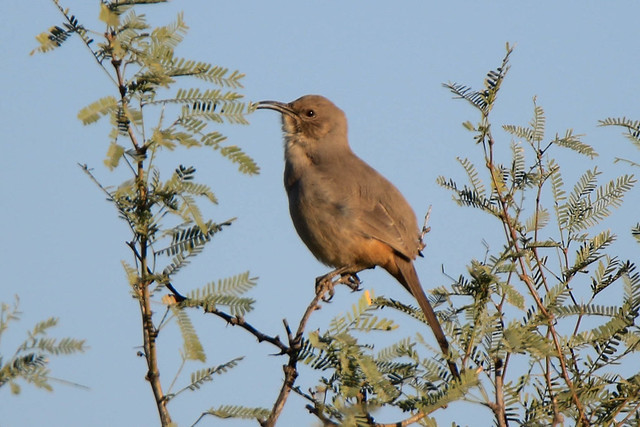
One has to go far to see the Fulvous Whistling-Duck in the US. They occur in small numbers in Florida and southern Texas. (And yes, they do whistle!) To see this flock, I had to go to Southern Florida, sign up for a birding tour to a stormwater treatment area, and then drive for two hours to get there. But it was worth it - this was the last regularly-occurring American duck left on my list to see. (As the birders say, "Done with Ducks!")

This is another northern bird that sometimes comes down to our area for the winter. This Bohemian Waxwing is a cousin of the more southerly, numerous, and more regularly seen Cedar Waxwing. They are "irruptive", meaning that some years there are more of them coming south than in others. Last year, there were multiple reports of them around Lake George, NY area. And so as a dedicated birder, one Sunday I got in my car and drove for 5 hours up there, trying different locations, and finally seeing a flock of them on a crab-apple tree near a Pizza Hut. (The drive itself, in the Adirondacks in the winter, was spectacular too!)
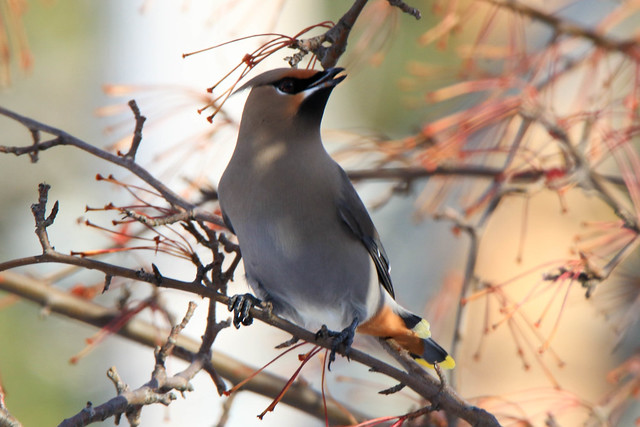
Bicknell's Thrush is one of the most localized breeders in the US. This bird lives only on mountaintops (at elevations above 5,000 ft) in few places in the Northeastern US. I found this guy during a trip up to Mt Washington in New Hampshire - most people get the "This car climbed Mt Washington" sticker, but I got this picture!
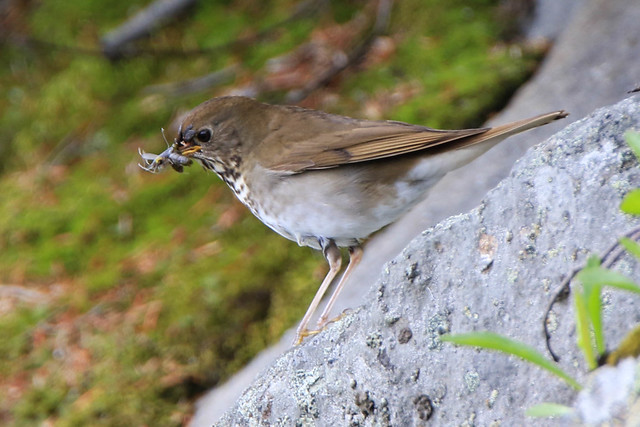
The American Three-Toed Woodpecker gets an award for being the highest-elevation rarity we ever found. We got it on a second try at the Monarch Pass in the Colorado Rockies, above the altitude of 12,000 ft. It is uncommon, likes high elevations, and also likes burned out or diseased forests - a tricky combination. Rather than peck, it picks at the tree bark and gleans the insects under it. Since photographing this bird, we also heard and briefly glimpsed another one in Alaska.
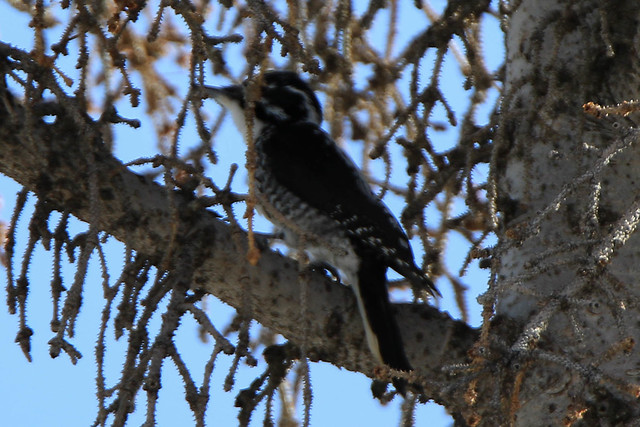
Upland Sandpiper is a shorebird that doesn't like the shores. It is found in large grassy areas, mostly in northwestern prairie US states and Canadian provinces. However, there are some that live in the east too, including a few pairs in New Jersey. In NJ, they live only in one place right now - which happens to be McGuire-Dix military base (same place where the Hindenburg zeppelin burned down). And this is where I saw the bird in the picture below. I could only get there on an official birding tour, sponsored by someone within the base itself, and it took me two years to finally see it.
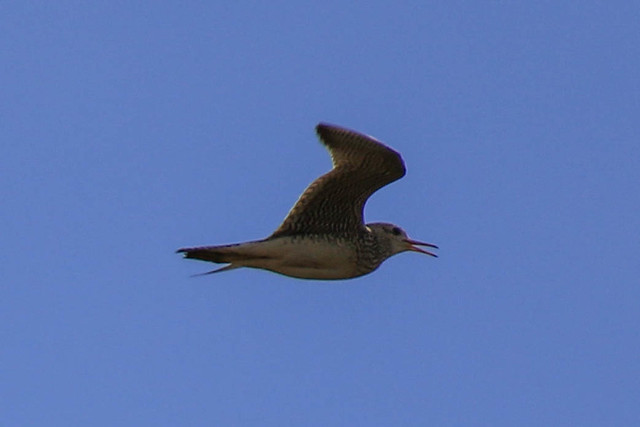
This guy barely poking through the reeds is a Nelson's Sparrow. It is uncommon and lives in the freshwater and saltwater marshes. To see this one, I had to go up to Maine, drive for a few hours north of the place we were staying, and then wade into the marsh to get a close look. And even then, all I got was this peek-a-boo.
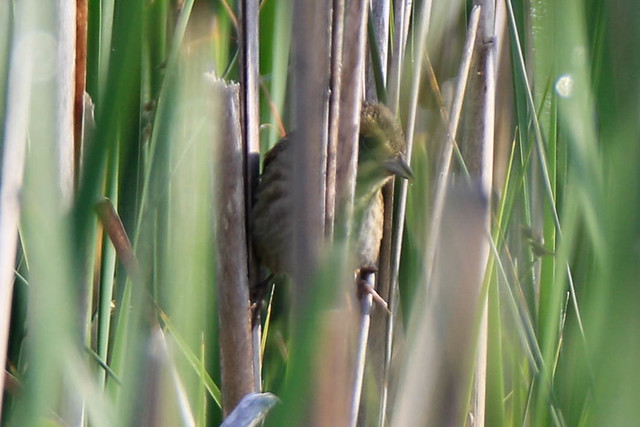
This dark small bird is a Leach's Storm-Petrel. Petrels are oceanic birds, rarely seen near land, and so to see any of them you have to go on a whale watch or a pelagic tour. Another petrel species, called Wilson's Storm-Petrel, occurs in every single ocean and sea, and might be the most abundant bird on Earth. Leach's Storm-Petrel, on the other hand, is much more local and rare, and even when it nests on an island, it (unlike other seabirds) does not come home until after sunset. I picked out this one by sheer luck in a flock of Wilson's during a whale watch in Bar Harbor, ME.
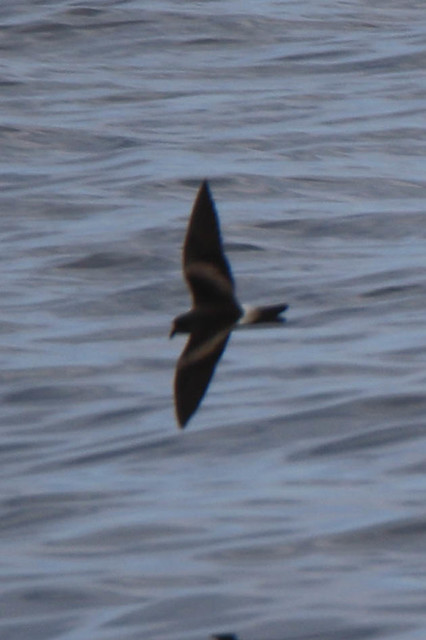
This is the bird for which I had to travel farthest from my home. It lives three airplane flights and a two-hour car drive away from me. Victoria Riflebird is a bird-of-paradise, which I saw on a tour in Northern Australia. As birds-of-paradise do, it puts up an impressive mating display and makes really loud calls. It was a highlight of my birding tour around Port Douglas, and (sadly) might be the only bird-of-paradise that I ever see.
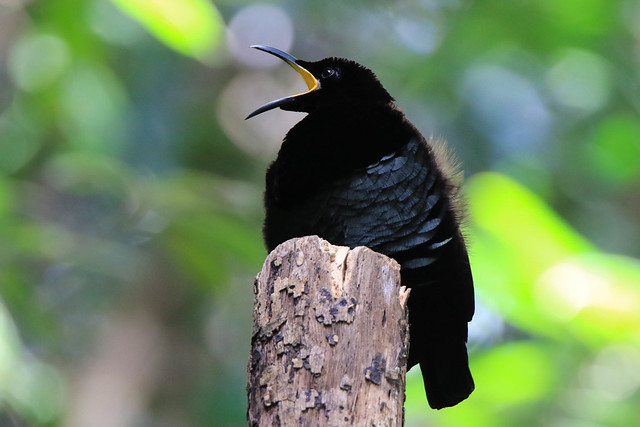


No comments:
Post a Comment